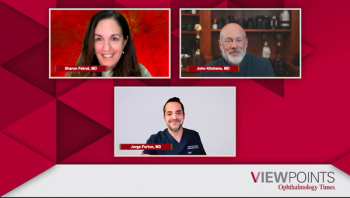
Ravi Patel, MD, shares ASCRS 2025 insights on enVista ASPIRE IOL user experience
Key Takeaways
- Real-world evidence is crucial in shaping cataract surgery practices, emphasizing enhanced monofocal IOLs like enVista ASPIRE and toric lenses.
- A survey of six experienced surgeons showed high satisfaction with enVista ASPIRE lenses, especially for full-range visual outcomes.
Discover how real-world evidence shapes cataract surgery practices, highlighting user satisfaction with enhanced monofocal IOLs at the 2025 ASCRS Annual Meeting.
At the 2025 ASCRS Annual Meeting, held April 25–28 in Los Angeles, California, several presentations highlighted the growing role of real-world evidence in shaping cataract surgery practices, and among them was a retrospective analysis presented by Ravi Patel, MD, MBA, a cornea and refractive surgeon at Atlantic Eye in Monmouth County, New Jersey, and a member of the cornea service at Wills Eye Hospital in Philadelphia.
Patel’s study focused on user experience for ophthalmologists with enhanced monofocal intraocular lenses (IOLs)—specifically the enVista ASPIRE and enVista ASPIRE toric lenses. All told, he and colleagues surveyed 6 experienced cataract surgeons across multiple centers in the United States, all of whom had performed an average of nearly 2000 cataract surgeries annually and had implanted the EA and/or ETA lenses in at least 5 of their patients. The retrospective survey captured provider-reported data on lens utilization, satisfaction, and perceived clinical outcomes. Notably, toric IOLs were used in more than 40% of the procedures, and EA/ETA lenses were among the most frequently chosen, particularly in cases aiming for full-range visual outcomes.
Across key measures—including centration, visual quality, and rates of visual disturbances—respondents expressed high satisfaction with both the EA and ETA lenses. On a 0–10 scale, 83% rated their satisfaction with the EA lens at a 9 or higher, with 100% of respondents giving the same rating for the ETA lens.
While on-site at ASCRS, Patel caught up with Ophthalmology Times to discuss the study, the significance of these data in guiding lens selection, and how these lenses fit into the surgical workflow.
Ophthalmology Times: As you know, in the real world, things work differently than in trials, so can you tell us a little bit about the data collected in this different environment?
Ravi Patel, MD, MBA: I think that's probably a statement of fact. In the real world, nothing works like it does in the clinical data, so we always want that real-world experience to base our factors on. The study that we did was based on 6 health care providers, and we got their perspective on using the enVista ASPIRE toric and the enVista ASPIRE, which are enhanced monofocal lenses. So, the goal was to see how this compares to other existing monofocal platforms out there in terms of the surgeon experience, the ease of insertion, and what they felt their postoperative outcomes were.
Were there any standout data points or surprises among what the health providers were responding with regarding their patient cases?
When the doctors responded, what was most surprising was how easy it was to use. It just kind of seamlessly integrated into their workflow because they had already established protocols for using monofocal lenses and monofocal toric lenses, so adding an enhanced monofocal lens really wasn't that much of a detraction to putting it into the workflow. The respondents found that it behaved exactly as they expected and sometimes even exceeded their expectations of what the current technology lets them do.
This is a technology that was off the market briefly and has just returned, so what is the mood around this for providers? Are they eager to use it? What are you hearing at the meeting?
I was so apprehensive about this because Bausch + Lomb did a voluntary recall on this lens platform back in March due to issues surrounding TAS, or toxic anterior segment syndrome. And literally, just on the heels of coming to the meeting, they gave us information as to what was causing the problem, they found a solution for it, and the product's going to come back to the market, so it's amazing to see all the buzz from my peers and colleagues about how excited they are to use the lens again in their practice. You don't know what you're missing until you don't have it anymore. When we had the lens, you didn't really hear as much buzz about it, but once it got taken off the market, my colleagues left and right were like, "When are we getting it back? When are we getting it back?" You start finding the niches that you were using it in, and then you miss it. I'm glad that in a couple of weeks, we'll all have it back.
Is there anything else that you want to make sure that your colleagues at home know?
Within the data, it's important to know that the application of using the enVista ASPIRE lenses is like using most of your other monofocal lenses. It's a one-piece hydrophobic acrylic lens. The properties of the lens behave like every other lens you're comfortable putting in. So if you haven't tried it, you should because I think you and your patients will be really happy putting this in.
Transcript edited for clarity.
REFERENCE
Patel R. Retrospective Real-World Evidence Study: User Experience with an Enhanced Monofocal Intraocular Lens. Presented at: ASCRS; April 25-28, 2025; Los Angeles, CA. SPS-211.
Newsletter
Don’t miss out—get Ophthalmology Times updates on the latest clinical advancements and expert interviews, straight to your inbox.














































.png)


